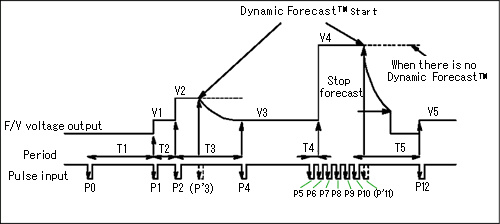 |
 |
 |
| Stage 1 |
: |
The first pulse P-0 appear initially, the period is not defined. So, the output is still zero. |
 |
| Stage 2 |
: |
When the next pulse P-1 comes the output V-1 calculated proportional to reciprocal value of pulse interval (period) T-1 appears. |
 |
| Stage 3 |
: |
By coming pulse P-2, the output V-2 appears. Here, the output V2 becomes higher than V-1 by reason of the interval T-2 is shorter than T-1. |
 |
| Stage 4 |
: |
If the P-3 makes same interval as T-2, the output still remain same voltage. |
 |
| Stage 5 |
: |
If the following pulse delayed as P-4, the hyperbola forecast computation begins from time point of imaginary pulse P-3. (The 2 reciprocal numbers are relationship of right angle hyperbola.) |
 |
| Stage 6 |
: |
The next pulse P-4 freezes a point of hyperbola forecasting curve. The voltage of the point is V-3, which is equal to reciprocal value of T-3. |
 |
| Stage 7 |
: |
If the many-fold of sudden increase of incident frequency, the analogue output rises to V-4 corresponding input change shown T-4. When the pulses continue in a same period the output keeps a voltage with no ripple shown in V-4. |
 |
| Stage 8 |
: |
For input pulse stop the hyperbola forecast starts after last pulse interval from last pulse. And after a settled timing the output voltage is cut down to zero as stop forecast. The settled timing is given as a coefficient of stop forecast. Actually the coefficient is given an integer. In all over applicable range, the forecast is done in relation to input frequency to obtain optimum operation. |
 |
| Stage 9 |
: |
If an input pulse P12 came after long period of stop reaction, an output V5 is given soon because of defined interval T5 that is determined with last pulse and new pulse P12. |


